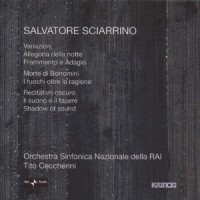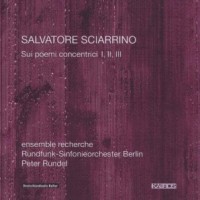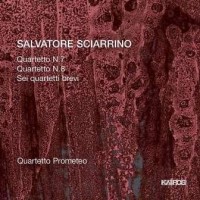Italian Vacation 10: Recent Sciarrino on Kairos
|
Grant Chu Covell [October 2013.]
Salvatore SCIARRINO: Variazioni (1974)a; Allegoria della note (1985)b; Frammento e Adagio (1991)c; Morte di Borromini (1988)d; I fuochi oltre la ragione (1997); Recitativo oscuro (1999)e; Il suono e il tacere (2004); Shadow of sound (2005). Francesco Dillona (vlc), Marco Roglianob (vln), Mario Carolic (fl), Moni Ovadiad (speaker), Daniele Pollinie (pno), Orchestra Sinfonica Nazionale della RAI, Tito Ceccherini (cond.). Kairos 0012802KAI (3 CDs) (http://www.kairos-music.com/). Salvatore SCIARRINO: Sui poemi concentrici I, II, III (1987). Ensemble recherche: Martin Fahlenblock (fl), Shizuyo Oka (clar), Melise Mellinger (vln), Barbara Maurer (viola d’amore), Lucas Fels (vlc), Rundfunk-Sinfonieorchester Berlin, Peter Rundel (cond.). Kairos 0012812KAI (3 CDs) (http://www.kairos-music.com/). Salvatore SCIARRINO: Quartetto No. 7 (1999); Quartetto No. 8 (2008); Sei quartetti brevi (1967-92). Quartetto Prometeo: Giulio Rovighi, Aldo Campagnari (vln), Carmelo Giallombardo (vla), Francesco Dillon (vlc). Kairos 0013212KAI (1 CD) (http://www.kairos-music.com/). Some English-language biographies of the Palermo-born composer (b. 1947) emphasize that Sciarrino is self-taught. Perhaps to American sensibilities, this suggests folks like Nancarrow and Partch who were outsiders by inclination. On these shores, where snobbishness prevails, self-taught composers are often considered unrefined or unschooled. They also might lean towards – gasp! – popular tendencies. Sciarrino’s classical education complemented his drift towards music. Having taught at the Milan conservatory, he now devotes himself fully to composition. As for being self-educated, Sciarrino found independence and resisted dogma in order to create a distinctive style. Perhaps there are similarities to Lachenmann in terms of texture and details. The works of the last decades feature vocal idiosyncrasies similar to the manner in which Janáček infused his works with Czech-language patterns. I have not had the good fortune to experience any of Sciarrino’s brilliant orchestral works live. While it’s true that he writes for large ensembles, the rare tuttis most often produce subtle, near quiet sounds. I imagine a conductor beating time as some players count rests while others deliver multiphonics and meticulous gestures. Sometimes a sound or a motive will repeat insistently. The orchestra may revert to non-standard techniques to simulate breathing, sighing and heartbeats. Kairos adds to their Sciarrino catalog two three-disc boxes of orchestral works and one of quartets. In Variazioni, quivering, near-noise tremolos shroud a timid solo cello. Indeed, it’s possible to miss the soloist. The variations don’t seem to be thematic. Perhaps we’re hearing how similar material fits in the shadows between silence and noise. The past brushes against the face of Sciarrrino’s feathery Allegoria della note, where snippets from Mendelssohn’s E-minor Violin Concerto intrude like interplanetary radio static. Perhaps because of the soloist’s tessitura, this one behaves more like a concerto. Given Sciarrino’s atmospherics and tapering phrases, the steely flute fits into his idiom perfectly. Frammento’s soloist executes much overblowing and breath work to create high pitches infused with noise. If Frammento was introverted, then the Adagio is even meeker. In 17th-century Rome, two architects dominated Baroque architecture: Gian Lorenzo Bernini and Francesco Borromini. With the impressive physical evidence still standing, visitors to Rome can’t escape their sway. Borromini was perhaps more inventive and capricious. He committed suicide in August 1667, with his final days documented by the attending physician. Including speaker to read the doctor’s notes, Sciarrino’s predominantly quiet work portrays a troubled mind. Morte di Borromini progresses gradually from sustained calm over brass warbling towards tightly wound frenzy. Sciarrino employs wind multiphonics strident whinings of which overwhelm the orchestra’s final minutes, as if a fire alarm – destabilizing rather than noisy. At the 19-minute mark, I fuochi oltre la ragione (“The fires beyond reason”) upends with a metronomic, variably high-pitched percussion beat (perhaps xylophone and claves) persisting throughout the concluding 12 minutes. The end wastes away. Morte and I fuochi undergo irrevocable transformations. With simple but assured means, they terrify and exhaust. Other composers might glamorize similar agitated states, whereas Sciarrino succeeds with less. Daniele Pollini (Maurizio’s son) navigates Recitativo oscuro, another unconcerto-like concerto. Over an ominous percussive heartbeat, the piano suggests small chords and clusters. Ineffectual solo motions penetrate burbling winds, breathing noises and gentle mouthpiece popping. Il suono e il tacere ruminates upon a simple gesture: a small turn finished with a downwards glissando like a weary sigh or shrug. As the gesture gently mutates, the background grows stronger: muted brass yielding to strident winds. A subtle heartbeat might initially be mistaken for the thumping bass of a passing muscle car. The work grows more morose, insistent and upset. Outstandingly simple to grasp, and constantly changing, this is my favorite in the collection. Shadow of sound could be Il suono on a serious detour. The same sighing motion has a role, with the background emerging more insistently. Tremolando flutes suggest owls. Sui poemi concentrici’s astonishing size (47:40 + 49:38 + 45:29) should require paragraphs of commentary. In the interests of economy, let’s just say that its remarkably consistent material constantly churns. Extracted from a ten-hour score accompanying a presentation of Dante’s Divine Comedy, the title implies a series of intersecting cycles, with the dark, lingering evolution sounding rather cosmic or oceanic. Immediately identifiable and precisely textured moments reappear as circling events: wind multiphonics, brass mouthpiece slapping, a series of weeping violin chords, fluttertonguing. The soloists’ activities occur just above the surface, but don’t appear to represent Virgil or Beatrice. Fragile and enchanting, the discs end too soon. The 46:24 string quartet disc provides intense flavors. About double the length and nine years later, at 18:28, No. 8 could be an extension of No. 7. Harmonics and tremolo common in earlier Sciarrino are set aside for acutely expressive vocalized motifs. Taking advantage of the quartet’s ability to execute microtones and glissandos, longer pitches quiver and slide like entreating vowels. These pleading lines are often prefixed or suffixed for pungency with a jumping interval. Similar keening gestures appear throughout Il suono e il tacere and in the opera Luci mie traditrici. An infrequent abrasive harmonic or metallic sound contrasts with the humanoid sighing. Reproduced score examples reveal the notated precision that creates such ephemera. Neither quartet has an obvious structure or plan; both end abruptly. The Sei quartetti brevi span 25 years. The movements are marked I through VI. It would appear Sciarrino’s first six quartets constitute a group. Nos. 1, 3, 4, 5, and 6 are dedicated to Lachenmann, whereas No. 2 is for Franco Evangelisti. Curiously, the Arditti’s 1995 “from Italy” release (Montaigne MO 782042) notes that Nos. 1, 3, 4, 5, and 6 are “alla memoria di Pietro Marzani” with no mention of Lachenmann. These early miniatures offer feathery, harmonic textures calling short stories to mind. Unlike Nos. 7 and 8 there is no suggestion that they bear witness to something unspeakable. The Prometeo is more grounded in the Sei quartetti brevi, less flashy than the Arditti who emphasize the noise and scratchiness.
[More
Sciarrino]
[Previous Article:
Used Bin Troll Tweets D.]
[Next Article:
Tome Tweets 2.]
|


